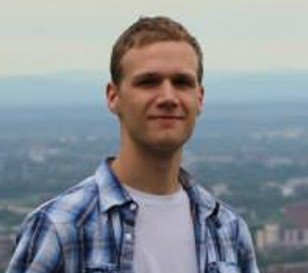Trace: » tsikourasa
This is an old revision of the document!

Anthony Tsikouras
Graduate student, PhD candidate in Engineering Physics
McMaster University - Photonics stream
Email: tsikoua@mcmaster.ca
Skype ID: atsikouras1
Office: ETB/529 | Lab: ETB/431
Office Phone: (905) 525-9140 x26196
Lab Phone: (905) 963-3777
Cell Phone: (905) 902-3897
SPIE Lecture Series:
Research
Fluorescence imaging typically involves tagging components of a sample with matched fluorophores, then measuring the fluorescence intensity of the sample when it is stimulated with an excitation source. Fluorescence lifetime imaging microscopy (FLIM) is a technique whereby the decay time of a fluorescence signal is used, instead of its intensity. While this adds a layer of complexity and cost, it can be a much more reliable method of obtaining information about the the cell's microenvironment. For instance, when a fluorophore is in close proximity to another molecule, Förster resonant energy transfer (FRET) occurs. In the FRET process, a fluorophore transfers its energy (which would normally be fluoresced) to the nearby molecule. This acts to quench the fluorescence lifetime, causing it to be shorter than the fluorophore's usual lifetime decay. Measuring the lifetime of the fluorophore can then be an excellent indicator of protein-protein interaction.
I am prototyping a high-throughput high content microscope system that implements FLIM for use in drug discovery systems. The system is being optimized for speed to match high-throughput standards, as well as high spatial and temporal resolution.
Publications
Tsikouras, A., Ning, J., Ng. S., Sinclair, P., Berman, R., Andrews, D.W., Fang, Q. (2012) Streak camera crosstalk reduction using a multiple delay optical fiber bundle. Optics Letters. 37: 250-252.
Conference Presentations
Tsikouras, A., Ning, J., Ng. S., Sinclair, P., Berman, R., Andrews, D.W., Fang, Q. (2012) High-throughput FLIM-FRET nanoimaging for quantification of protein-protein interactions in high-content screening [oral presentation]. SPIE Optics + Photonics (conference). 8460-04.
Schedule
Spring 2013 Plan
Summer 2014 Plan
Upcoming Plan
Planning Stage
I am on campus 9am-5pm daily in my office (ETB/529), lab (ETB/431) or in the Biophotonics Facility (HSC/4H22).
| Monday | Tuesday | Wednesday | Thursday | Friday | |
|---|---|---|---|---|---|
| 7:30am | |||||
| 8:30am | |||||
| 9:30am | |||||
| 10:30am | |||||
| 11:30am | |||||
| 12:30pm | |||||
| 1:30pm | |||||
| 2:30pm | |||||
| 3:30pm | |||||
| 4:30pm | |||||
| 5:30pm | |||||
| 6:30pm | |||||
| 7:30pm | |||||
| 8:30pm |
Courses taken:
| Course | Description | Semester |
|---|---|---|
| BME 701 | Biomedical Engineering Core I | 2010/2011 Term 1 |
| BME 706 | Biomedical Engineering Core II | 2010/2011 Term 2 |
| ECE 762 | Detection and Estimation Theory | 2011/2012 Term 1 |
| CSE 701 | Foundations of Modern Scientific Programming | 2013/2014 Term 1 |
| CE 6TN4 | Image Processing | 2013/2014 Term 2 |
Possible future courses:
| Course | Description | 2013/2014 |
|---|---|---|
| BIOCHEM 6H03 | Biotechnology and Drug Discovery | Term 2 |
| BIOCHEM 711 | Special Topics in Microscopy and Photonics | Not Offered |
| CAS 750 | Model-Based Image Reconstruction | Not Offered |
| CAS 755 | Advanced Computational Methods and Models | Term 2 |
| CHEM 6C03 | Statistics for Engineers | Term 2 |
| ECE 710 | Engineering Optimization | Term 2 |
| ECE 733 | Non-Linear Optimization for Electrical Engineers | Term 2 |
| ECE 771 | Algorithms for Parameter and State Estimation | Term 1 |
| ENG PHYS 726 | Optoelectronic Device Physics | Term 2 |
| ENG PHYS 734 | Nonlinear Optics | Not Offered |
| MOL BIOL 6H03 | Molecular Biology of Cancer | Term 2 |
Safety Training
| Base Courses | Additional Courses | ||
|---|---|---|---|
| Course | Date | Course | Date |
| WHMIS | 2009 | WHMIS Update | 2013/09 |
| Fire Safety | 2009 | Fire Safety update | 2013/09 |
| Biosafety 2 | 2011 | BSL-2 update | 2013/09 |
| Laser Safety | 2009 | Laser Safety Lecture | 2010 |
| Asbestos Awareness | 2009 | Emergency Code Procedures | 2013/09 |
| Ergonomics | 2009 | Transportation of Dangerous Good | TBA |
| Slips/Trips/Falls | 2009 | Chemical Handling | 2010 |
| Eng Phys Safety | 2009 | ||
| Electrical Safety Awareness I | 2012 | ||
Related Links
You are here: start » people » tsikourasa